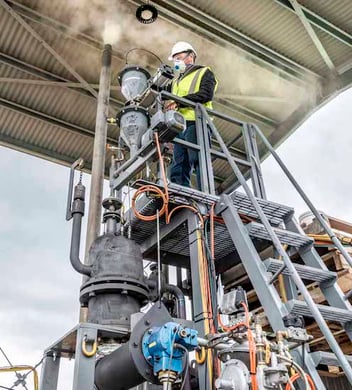Wastewater partnership leads the way in sustainable hydrogen production
With the support of South East Water, RMIT University researchers have developed a new technology that uses material derived from biosolids in wastewater treatment plants to produce hydrogen.
Published in the International Journal of Hydrogen Energy, the research outlines a patented technology that uses biosolids to create a chemical reaction producing hydrogen from biogas.
The method removes the need for expensive catalysts when creating hydrogen on-site at wastewater treatment plants, and also traps carbon, which may enable lower carbon emissions from the wastewater sector in future.
Lead researcher RMIT Associate Professor Kalpit Shah said the technology may help to overcome the challenges involved with existing commercial methods for producing hydrogen, which are capital intensive and create high emissions, and also rely on natural gas.
“Our alternative technology offers a sustainable, cost-effective, renewable and efficient approach to hydrogen production,” Shah said.
“To enable the transition to a circular economy, we need technology that enables us to squeeze the full value from resources that would ordinarily go to waste. Our new technology for making hydrogen relies on waste materials that are essentially in unlimited supply.
“By harnessing the power of biosolids to produce a fully clean fuel from biogas — while simultaneously preventing greenhouse gas emissions — we can deliver a true environmental and economic win.”
The method converts biosolids to biochar — a carbon-rich form of charcoal that contains heavy metals, which makes it an ideal catalyst for producing hydrogen out of biogas.
Researchers were able to show biosolid-derived biochar is highly effective for decomposing the gas into its component elements: hydrogen and carbon.
Increasing efficiency
RMIT designed a reactor able to produce both hydrogen and a high-value biochar that is coated with carbon nanomaterials, which can also capture harmful greenhouse gases to prevent release into the atmosphere.
“We’ve radically optimised heat and mass transfer in our reactor, while shrinking the technology to make it highly mobile,” Shah said.
“There are no reactors available that can achieve such phenomenal heat and mass integration, in such a small and cost-effective package.
“And while it’s already energy efficient, with further integration, this reactor could turn biosolids and biogas conversion into a process that actually produces energy instead of consuming it.”
South East Water Senior Research and Planning Scientist Dr Aravind Surapaneni said research into new and valuable uses for biosolids is vital, considering around 30% of the world’s biosolids resource is stockpiled or sent to landfill.
“The wastewater sector is constantly looking to develop new ways to transform biosolids into high-value products, in environmentally sustainable and responsible ways,” Surapaneni said.
South East Water Research and Development Manager Dr David Bergmann said the technology had potential for adoption by the industry.
“Supporting these kinds of innovative emerging technologies is an important part of our commitment towards reduced emissions and a circular economy approach involving wastewater,” Bergmann said.

